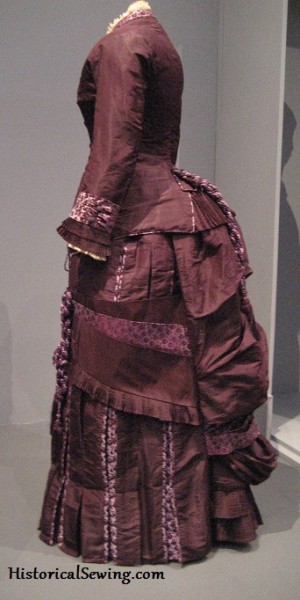
Ahh.. the Victorian Bustle Era. It’s so pretty! And aside from the huge poufy sleeves of the 1890s, it’s what most people think of when they hear “Victorian.” It’s the trimming. The opulence. The expensive laces. The multitude of fabrics – all on the same gown.
But did you know there are three distinct varieties that reside within these two decades?
Yep. 1871 looks like a distant relative to 1880 fashion. And by 1888 –that child resembles the grandmother, but not quite….
Let’s explore why these cousins kiss – and don’t.
From about 1868-ish to 1876 is known as the First Bustle Era, or Early Bustle, or simply 1870s Bustle. This is all about the poufs, the ruffles, the girly-ness.
Years from 1877 to 1882 fall into the Natural Form Era – “natural” as in the wired bustle contraption was left hanging in the closet and was replaced with a small pad resembling a woman’s “natural” curves.
Late Bustle, 1880s Bustle or Second Bustle Era came back strong in 1883 and lasted until 1889 when women had had enough of making their back side look disproportionally huge with the rest of body. The bustle was thrown out nearly overnight.
Early Bustle Era – 1868-1876
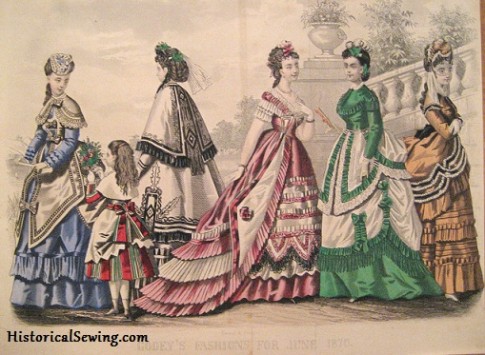
To study a fashion era, you must always start from where the styles are coming from. Fashion doesn’t change overnight. It’s a progression of change, pushed by influencing tides from celebrities and fashion designers.
Charles Worth, that celebrated King of Couture, felt the bustle coming long before anyone else. You can witness that by his addition of overskirts in the mid-1860s.
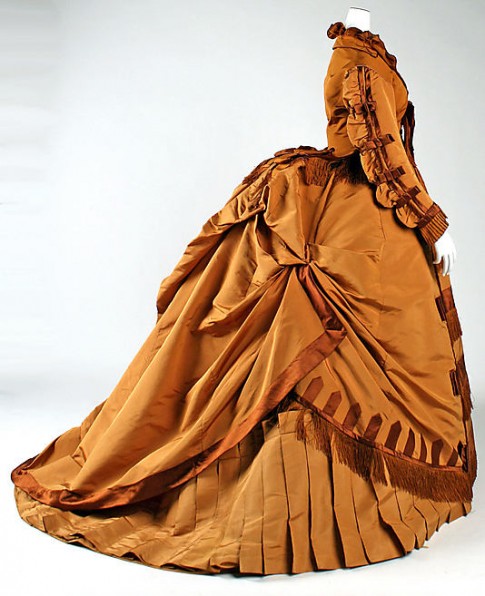
Starting with the elliptical hoop in the mid-to-late 1860s, we see the hoop start to collapse, or rather get smaller. (Guess they were done with squeezing through doorways!) Knee length overskirts were already popular so they stayed on top of the long skirt.
Now the skirt was already angling to the back with the elliptical shape. As the hoop width was reduced, they kept the angle towards the back. Well, what happens when you squeeze the sides of a hoop skirt but still want that back part? You pouf it up of course! 😉
The elliptical shape went down to a full A-line shape with the overskirts, and eventually the foundation skirt, being puffed up at the bum area.
Great… Now we need a new wired contraption to hold all that fabric up back there! So rises the Great Bustle! Yay!! (See? It all comes back to the silhouette foundation.)
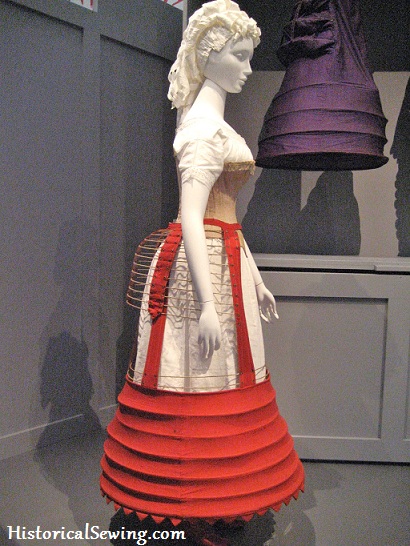
By now, thousands of households had sewing machines. So what would a woman at home with a new device capable of finishing a dress in only a day or two do with it?
TRIM! Trim the H-E-Double Hockey Sticks-LL out of the dress!! That’s what. lol
So if anything worth remembering about the 1870s Bustle is that there is TONS.OF.TRIM.
- Ruffles
- Puffs
- Ruffles with puffs
- Puffs with ruches on top, on bottom
- Ruffles on the sleeve cuffs, on the skirt, under the skirt, on the petticoats to hold out the skirt.
- And don’t forget the fabric bows.
- The braids
- The laces
- And when you’re done with that – layer all of the above. 😉
The designs, although now covered with self or coordinating fabrics and laces, stayed as they had in the 1860s – symmetrical. Both sides of the dress looked the same. Until, of course, they got bored of that and decided to play with lines of design. But that’ll come later….
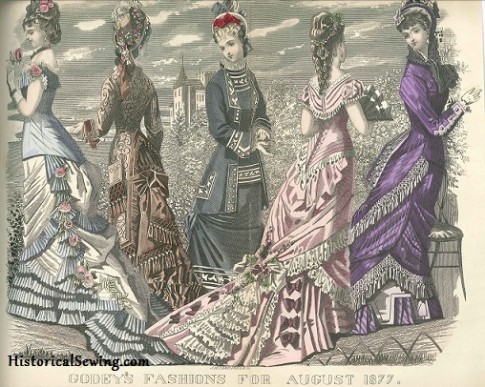
By the mid-1870s you can see the width of the skirt has narrowed some. (They simply took the hoop wires out of the bustle hem.) They also put on more trim. They are trimming the trims now! They also got crazy with trains.
But you can see from the 1877 plate above that the trims are still placed symmetrically. Yep. That’s important when looking at the differences between the bustle eras.
Well, at some point they got tired of all that skirt weight (but apparently not the trims), so they started leaving the bustle at home. Oh, it feels so good to sit back against the chair again! And this is the transition to the next fashion….
Natural Form Bustle Era – 1877-1882
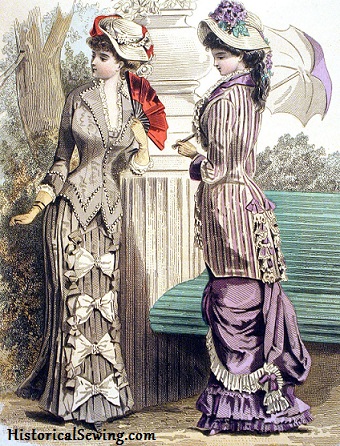
By the late 1870s the skirts were slimmer and only to get even tighter around the legs in a few years. The main skirt support was a small pad at the back and a petticoat or two. I suppose if you have enough “natural padding” the pad can be left off altogether.
Overskirts were tighter around the foundation skirt and fancy drapes in the back were appearing in all sorts of complicated shapes. Bodices were tightened and lengthened around the non-bustle skirts into a cuirass bodice – a shape that mimics the long corset shape.
Styling was very much coming from the earlier puffy shapes but was now looking better shaped to the figure. Slim was in!
This era also created what we know as the Princess Dress. Or rather, it was a full-length dress with princess seams to fit the figure and no waistline seam. The long lines emphasized height and skinniness (if you can imagine that in the Victorian years!). The Dressing Gown became uber popular.
Vertical lines down the whole body gave the awesome idea to start trimming even more on the various angles created in the skirts. Many, many gowns of this time were loaded with gathered up fabric. Self-fabric strips (more trim!) were gathered up and sewn on vertically to emphasize that long look.
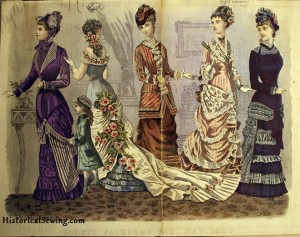
Now, this period was still focused on skirts. And hips – the Victorian hourglass shape. So in the early 1880s while still only wearing the bum pad, they decided wide hips ruled. (Oh, how I love thee!)
The overskirt draperies were split down the center front and pulled up over the hips. Front aprons were pulled back to widen that hip area. Add fringe and flowers to top it off.
Apparently you can only increase the hip width so far without looking like Marie Antoinette – no wonder we call 18th C. side hoops “panniers”! – It was a term created by the Victorians circa 1880. So here comes the next change…
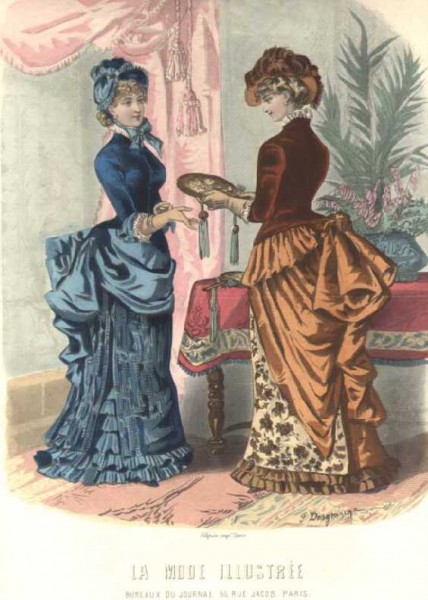
They pulled up those front aprons so much that all that fabric ended up piled on the back side again. “Hey! We need to support all this. What about those old wire contraptions at the back of the closet?” Which leads us to the Second Bustle Era.
Late Bustle Era – 1883-1889
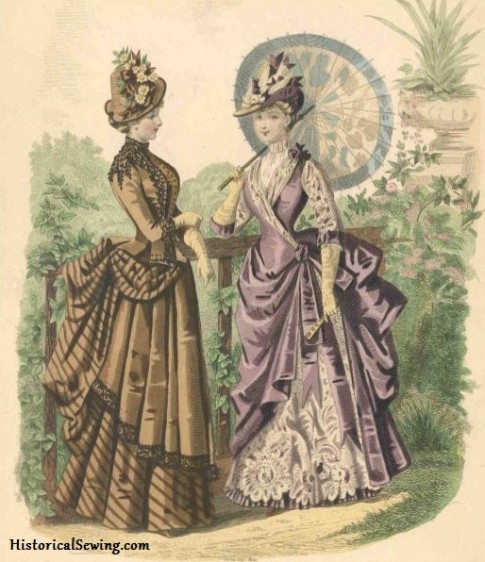
By this time, the bustle became the affectionate “lobster tail” as it kept the skirt front smooth but helped support the back poufs. That back side became HUGE.
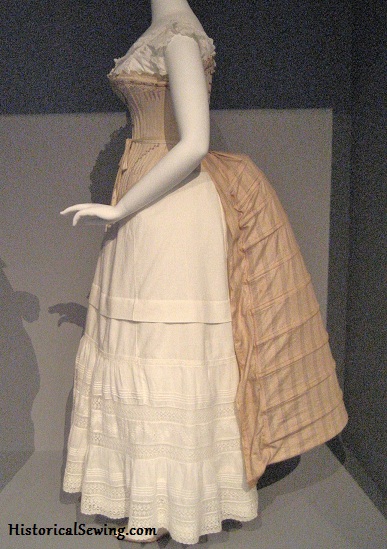
You might know the 1880s Bustle as “fashion of the Wild, Wild West.” It was fashionable yet conventional, and they had left all the frou-frou of the 1870s behind. Instead, they decided to play with style lines of the skirts by moving the overskirt layers off-center. It was all asymmetrical, baby!
Tailoring was especially noticeable on these dresses. The fit was very fine. The fabrics were high-end wool, and satins –many times combined. Necklines were high to the neck. Sleeves hugged the arm showing minimal decoration.
By nightfall, arms were fully exposed with perhaps only a flutter or two of lace attached to the bodice armhole.
It was all refined and elegant. No more foofy-ness from childhood. However, laces were widely popular and hung in graceful drapes in-between fabric panels of the skirts.
The last hurrah came around 1889 when sleeves started to pouf a fit at the top. This, they decided, was much easier to maneuver than large, bustled skirts…. Little did they know that in just a few years they’d have to slide sideways through the door because of their enormous sleeve width. But that’s a topic for another day….
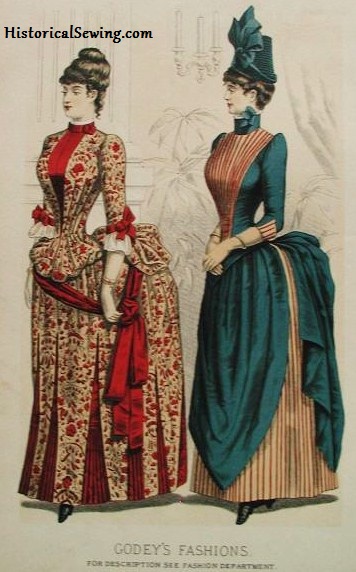
Which Bustle Era do you gravitate to – the 1870s for its puffy skirts, the Natural Form for its slim silhouette, or the 1880s for the tailored appearance?


1880 dress on Pinterest
Avis aux plus expérimentées:
Ce modèle que j’aime beaucoup me pose problème. Tel qu’il est, impossible de s’assoir!…Ou alors, la jupe est ouverte sur le devant (en dessous des fronces) ou peut-être y a-t-il des plis sur la couture du milieu dos de la jupe permettant les mouvements de la marche….A moins que c’est une gravure aux courbes exagérées et qu’il interpréter le modèle avec des mesures normales?…. Merci pour ce blog passionnant et généreux. from Belgium
It is a beautiful era of dress! But yes, very tightly fitted to the hips. But a woman can absolutely sit in these elaborate dresses! It is generally done by perching on the end of a seat rather than in the soft furniture and automobiles we have today. Today’s furniture does not match to Victorian fashion. 🙂
Take note that this is a drawing and not a dress on a real woman. So the artist took liberties with the fit of the dress. Moving and sitting in real clothing will move and shift when wearing. The cut of the skirt can be widened; however, the overskirt falling to the side or “open” shouldn’t be a big concern. That front overskirt hem could be tacked to the foundation skirt but then it may stress the stitching when walking and sitting. I’d recommend the overskirt to simply lie loose over the foundation skirt for movement. Do a search of photographs of women from the 1880s to see how they are sitting and standing in the photos and how the skirts are cut to their figure.
C’est une belle époque vestimentaire ! Mais oui, très bien ajusté aux hanches. Mais une femme peut tout à fait s’asseoir dans ces robes élaborées ! Cela se fait généralement en se perchant au bout d’un siège plutôt que dans les meubles rembourrés et les automobiles que nous avons aujourd’hui. Les meubles d’aujourd’hui ne correspondent pas à la mode victorienne. 🙂
Prenez note qu’il s’agit d’un dessin et non d’une robe sur une vraie femme. L’artiste a donc pris des libertés avec la coupe de la robe. Bouger et s’asseoir dans de vrais vêtements bougera et se déplacera lors du port. La coupe de la jupe peut être élargie ; cependant, la surjupe tombant sur le côté ou “ouverte” ne devrait pas être un gros problème. Cet ourlet de surjupe avant pourrait être fixé à la jupe de base, mais cela pourrait alors stresser les coutures lorsque vous marchez et que vous êtes assis. Je recommanderais que la surjupe soit simplement lâche sur la jupe de base pour le mouvement. Faites une recherche de photographies de femmes des années 1880 pour voir comment elles sont assises et debout sur les photos et comment les jupes sont coupées à leur silhouette.
Were there any alternatives to the bustle shape? It seems like this emergence would have been deemed by at least _some,_ however few, as extremely vulgar, but at the same time I know some (probably the same people) condemned “eccentricity of dress.” I can only imagine being caught between these two ideals and trying to decide which is more important.
You are exactly right that a particular slice of society would not approve of the extreme bustle shape/shaping. Just as fashion opinions range today…. Here’s another blog post that will show the “puffing up of the back side” isn’t just an 1870s thing.
Thank you for the detailed description of bustle fashion over the years. You provided the best help to date a lovely (unidentified subject) studio photo in my old family album. I think the plain fitted sleeves and the overskirt/apron with front folds drawn back and draped at the back date it to the 1880s.
So glad to hear this post helped! 🙂
This was so informative thank you!!
I’m having a problem if anyone with knowledge of this could help me I would be forever great full!
I am trying to recreate Laura Ingalls brown poplin dress to the best of my ability, she talks about it having a bustle and hoop all attached with the bustle she could tie in front of her to make it smaller. Going by the dates I believe it’s 1882 but I could be wrong there is some conflicting sources lol!
So I am wondering what a polonaise is at that time, she talks of it being high neck with buttons down the front which I can visualize, but I can’t seem to get the skirt in my mind. Would it be split in the front or all the way around?
Thanks! 🙂
A polonaise is a bodice garment that has the overskirt attached to the bodice for one piece with no waist seam. It became popular in the early 1870s and continued through the early 1880s. Here is one fashion plate example (red stripe) for reference. You can also scan that same board of Victorian Bustle Dresses I’ve compiled. The polonaise (bodice) was most often split in front below the bottom button closure. It was worn over a foundation skirt. Often in this era, bustle wires were built into the foundation skirt with ties to adjust the fullness of the back bustle shape. Here’s another pin of a 1885 foundation skirt pattern (or petticoat) showing the casings for the hoop wires for the bustle effect.
Best of luck in your research and project!
Thank you Jennifer. You’ve guided me through my first 1881 dress (making it so I can join a brother Cowboy re-enacting). At this point I need some advice. I’ve finished the skirt and overskirt and have Truly Victorian’s TV-460 Cuirass bodice pattern. This will be a day dress. Given it is going to be worn during a Texas summer, do I really have to do the high neckline? or can I use the open square neckline in the pattern? Can’t find any summer dresses that don’t show a woman buttoned up to her chin.
No. You can cut a narrow V or narrow square opening to open up the fabric around the front of the neck. Don’t make it too open or you risk sun exposure and may need a chemisette underneath. Also, be sure to use super light, cotton (or linen) fabric. Sheer wool (harder to find) is also a good option. For photo proof I’d recommend general image searching with keywords like Texas, Deep South, summer, 19thCentury, 1800s and similar. Here’s an original dress that is styled as a summer tennis (day) dress with shallow, open neckline.
Thank you so much for the tip Jennifer!
Thank you for the information on the dresses.lots of design changes one the era.
Love your site. Now I know what era the ghost I see now and then is from. I live in an old feed mill that ran from 1700s to 1900s . I found out it was a train station too.
Thanks again
Helen B
….. no one is gonna mention the ghost????? is it a nice ghost or a scary ghost. has anyone else seen it? Have you found any photos that matches the identity? Have you tried contacting them?
Loved the article by the way, but… ghost…?
Nice!
Jennifer, do you have the free pattern for a bustle dress?
I’m not aware of a free pattern for a bustle dress. You can watch my tutorial on bustling a skirt here, but a pattern for an entire dress I’m not sure of. You might check online for Victorian dressmaking sources for original patterns.
Jennifer, what tools did you need for a bustle dress
Look, at those wonderful photos, That makes me having the right style of clothing.
Whoa, nice bustle dresses!
Natural form for sure. All of it is eye candy though. The extravagant frills make my Rococco spirit sing.
I’m an 1880s girl now and forever.
I like the 1880’s tailored look the best! ^^
It’s a great article, Jennifer. I’ve re-read it several times when I needed a refrsher.
I still love the elegance of the elliptical hoop and the girliness of the 1870s bustle. I am entirely too horizontal to carry off the Natural Form and the high necklines of the late bustle are suffocating and unattractive on my build.
Love this! I am definitely an early bustle-natural form girl. I have never liked the late bustle era:).
Blessings,
Kim